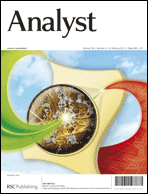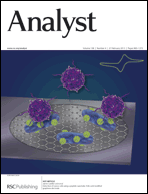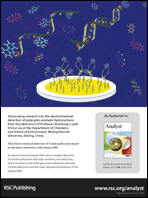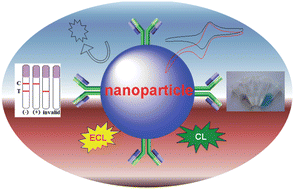The issue 4 of Analyst has now gone online! We have three beautiful covers showing new research coming from three different countries: China, Denmark and USA.
The outside front cover of this issue resembles the SERS-active paper dipsticks developed by Wei Yu and Ian White at the University of Maryland, USA. The paper-based devices fabricated by inkjet printing allow collection of analyte molecules from a liquid sample by simply dipping the paper into the sample. According to the authors, these paper dipsticks can be used to process much larger sample volumes than conventional SERS substrates.
Inkjet-printed paper-based SERS dipsticks and swabs for trace chemical detection
Wei W. Yu and Ian M. White
Analyst, 2013,138, 1020-1025
DOI: 10.1039/C2AN36116G
Our inside front cover offers a snapshot of Jaime Castillo-Leon‘s work, from the Technical University of Denmark. His study focuses on the development of a graphene-electrode modified with peptide nanotubes and folic acid to specifically detect cervical cancer cells over-expressing folic acid. Application of this graphene-sensor to the diagnosis of other diseases where cells over-express folic acid is also discussed.
Detection of cancer cells using a peptide nanotube–folic acid modified graphene electrode
John J. Castillo , Winnie E. Svendsen , Noemi Rozlosnik , Patricia Escobar , Fernando Martínez and Jaime Castillo-León
Analyst, 2013,138, 1026-1031
DOI: 10.1039/C2AN36121C
Finally, on the back cover is an image featuring a study led by Xiaohong Li and colleagues from the Beijing Normal University. In their paper, the researchers introduce an electrochemical hairpin DNA sensor which enables direct detection of the polycyclic aromatic hydrocarbon 9-hydroxyfluorene and they demonstrate efficient detection in lake water.
Electrochemical detection of 9-hydroxyfluorene based on the direct interaction with hairpin DNA
Gang Liang , Xiaohong Li and Xinhui Liu
Analyst, 2013,138, 1032-1037
DOI: 10.1039/C2AN36255D
In addition to our covers, here is an interesting minireview about recent developments of nanoparticle-based immunoassays in the biomedical field. Dianping Tang and and co-authors from the Fuzhou University in China outline the nanoparticle-based electrochemical, optical, colorimetric assays used so far and discuss future applications. To read the full article, please access the link below:
Nanoparticle-based immunoassays in the biomedical field
Dianping Tang , Yuling Cui and Guonan Chen
Analyst, 2013,138, 981-990
DOI: 10.1039/C2AN36500F














